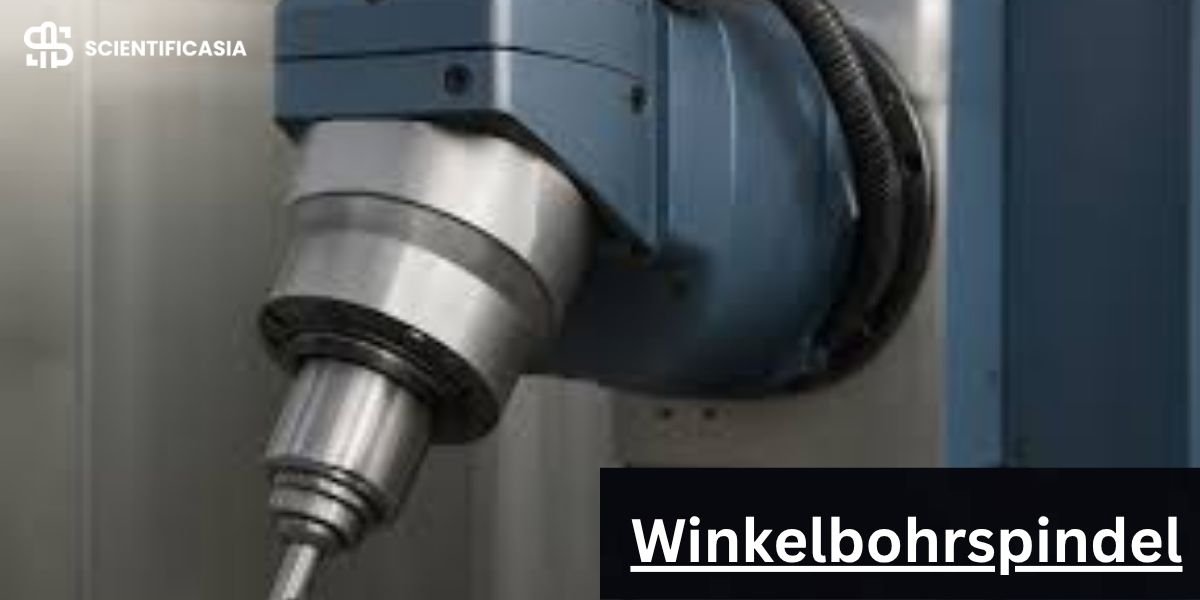Introduction: What is a Winkelbohrspindel?
1.1 Core Definition and Purpose
A Winkelbohrspindel is German for “angle drilling spindle” or angle head. It is a special attachment that lets a machine drive a tool at an angle, rather than straight ahead. Power is redirected from the main spindle through an internal gear mechanism.
Why use one? It helps you do drilling, milling, and tapping in places that are hard to reach, or on faces of a workpiece where a straight-on tool does not work. You avoid complex re-fixturing of the workpiece. That saves time and reduces errors.
1.2 Consumer vs. Industrial Models
- Consumer / DIY models: These are lighter, simpler attachments. Think cordless drills or light benchtop machines. Low torque, modest RPM, often fixed angle or limited adjustability. Good for home improvement, wood, and light metals.
- Industrial models: Built for precision, heavy loads, tight tolerances. Used on CNC machining centres. They handle milling, tapping, heavier cutting loads, sometimes with through-coolant, high precision bearings, etc.
2. How a Winkelbohrspindel Works
2.1 Internal Power Transmission
Inside, there is a bevel gear system (straight bevel or spiral bevel). The input from the machine spindle goes into this gear set, which changes the direction of rotation to the tool output spindle.
The gears must be well-aligned and hardened. If they are spiral bevel, they reduce vibration and noise compared to straight bevel ones. The drive ratio is often 1:1, but sometimes gear reductions appear if torque or speed adjustment is needed.
2.2 Key Components
- Machine Interface: The part that connects to your machine’s spindle. Could be BT taper (e.g., BT40), CAT, HSK, etc. It must match for accuracy and rigidity.
- Gear Housing: Encloses the gears and bearings. Provides protection, alignment, and support.
- Tool Interface: The output spindle that holds the cutting tool. Often ER-collet chucks or chuck systems. Needs to have minimal run-out.
- Coolant Channels: Many industrial angle heads have through-tool coolant or external coolant channels. This helps cooling, chip evacuation, and prolong tool life.
3. Major Benefits
3.1 Access to Confined Spaces
You can reach into corners, side faces, recessed areas without reorienting or reclamping the workpiece multiple times.
3.2 Improved Efficiency and Productivity
Fewer setups. Less operator time. For many angled operations, an angle head is a cost-effective alternative to a full 5-axis machine.
3.3 Enhanced Precision and Repeatability
High-quality angle heads have low run-out, stable bearings, and tight tolerances. This improves hole accuracy, surface finish, and tooling life. Repeatability between setups or machine cycles is better.
4. Critical Selection Criteria
4.1 Drive Type: Guided vs. Unguided
- Unguided: The angle head is supported only by the machine spindle. Lighter, fewer parts. Good for light to medium work. But overhang and load can cause deflection.
- Guided (Supported / with support arm or torque arm): Has an extra fixture or bracket that holds part of the load, reducing vibration and deflection. Needed for heavy milling, deep slots, and large cutting forces.
4.2 Performance Specifications
- Max RPM: How fast the output spindle can turn without undue vibration. Higher RPMs are important for small tools and finishing cuts.
- Max Torque: Important for heavy cuts, or when output angle or gear reduction reduces torque.
- Run-out Precision: How much the tool’s tip deviates from perfect rotation. Usually expressed in micrometres. Lower run-out = better accuracy. High-end industrial models often guarantee very low run-out.
4.3 Physical Compatibility
- Match the machine interface: BT, CAT, HSK, etc.
- Size and reach: The length of the angle head, the diameter,and the projection. It must fit into your working envelope without interfering with fixtures, clamps, tool carousel, etc.
- Weight: Lighter heads reduce inertia and stress; heavy heads may need support.
4.4 Angle Type
- Fixed Angle (often 90°): Stronger, simpler, more rigid. Best for repeat operations at the same angle. Better accuracy.
- Adjustable Angle (0°-90°, or more): Offers flexibility. One head can serve many angles. But moving parts give less stiffness, more risk of misalignment if not set properly. Usually less torque or rpm vs fixed.
5. Common Applications
5.1 Manufacturing Industries
- Aerospace: Structural components often need holes, inlets, or slots at angles. Cooling channels etc.
- Automotive: Engine blocks, transmission housings, cylinder heads often have features on side faces or internal cavities.
- Mold & Die Making: Cooling channels, slides, detailed features at angles. Good access matters.
See Also:
The Importance of Teckaya Construction Equipment Ltd: A Strategic Analysis
Predictive Quality Control: How AI And Machine Learning Enable Smarter, Preemptive Manufacturing
5.2 Practical Use Cases
- Drilling holes in the side of a workpiece, e.g. a box, casting, etc.
- Milling deep slots or pockets in corners where straight tools can’t reach.
- Tapping threads in hard-to-reach areas: using tapping angle heads.
6. Installation & Maintenance
6.1 Installation
- Clean the machine spindle taper, inspect for damage.
- Fit the angle head interface correctly (match taper etc). Use proper torque.
- If using anti-rotation stop blocks or support arms, ensure they are installed.
- If coolant through head: ensure connections sealed, filters clean.
- If ATC (automatic tool changer) is used: check if the angle head is compatible in size/weight so ATC can handle.
6.2 Maintenance Tips
- Regular lubrication. Bearings need grease or oil (depending on model). Gears too.
- Inspect seals and coolant channels (for leak, blockage).
- Monitor vibration. If you hear or feel vibration unexpectedly, stop and check alignment, run-out.
- Check run-out periodically. Use dial gauge.
- Avoid overloading: respect ratings of torque, RPM, depth of cut.
7. Troubleshooting & FAQs
7.1 Common Questions
- Can it be used in an automatic tool changer (ATC)?
Many angle heads are made to fit ATC, but only if they stay within weight and size limits. If too heavy or large, the ATC may not handle or mis-index. - Is there a loss of speed or torque?
Yes, some loss occurs because gears are in the path. Also, friction, bearing losses. Fixed angle heads tend to lose less compared to adjustable models (because they have fewer joints or looseness). - What is the difference between cheap and professional models?
Cheap ones often have higher run-out, less precise gears or bearings, weaker housings, less cooling, poorer sealing. Professional ones have tighter tolerances, better materials, more support, longer life.
7.2 Troubleshooting
- Why might the spindle be vibrating?
Possible reasons: misalignment, worn bearings, poor balance, overhang too large, tool holder not seated, tool holder run-out too high. - How to reduce run-out?
Ensure clean, correctly fitted taper; quality collet or chuck; minimal overhang; use fixed angle when possible; maintain bearings and gears; check for wear or play in joints.
8. Top Brands and Market Overview
- BIG KAISER / BIG Daishowa: High-precision units. They offer fixed angle, universal heads, small bore types, etc. bigkaiser.eu+3bigkaiser.eu+3BIG DAISHOWA—Americas+3
- BENZ (Germany): Known for adjustable-angle heads, fixed-angle heads, and robust design. AE International
- Heimatec: Produces driven angle heads, etc, in many high-precision applications. (Mentioned in articles) Cutting Tool Engineering+1
- Other manufacturers: SOTECH, Drake, Yih Kuan, etc.
Read more blogs
Luma AI Dream Machine: The Future of AI-Generated Videos
Armature winding machines for producing high-frequency coils
The Impact of Motor Winding Machines on the Electric Vehicle Industry
Torque and Speed Loss
An angle head is not 100% efficient.
- Most high-quality industrial models lose about 3–5% speed and 5–10% torque because of gear friction.
- Cheaper models can lose more — sometimes 15% torque or higher.
- Loss depends on gear type: spiral bevel gears have smoother transfer and less loss than straight bevel gears.
- Rule of thumb: always size your tool and cutting parameters assuming a small loss in both speed and torque.
Safety Considerations
- Binding risk: If a cutter jams, gears and bearings inside the angle head can crack. Always follow torque ratings.
- Coolant leaks: If coolant enters the bearings, it can wash away grease and cause failure. Check seals often.
- Overheating: At very high RPMs, gears heat up. Without proper lubrication, this shortens life.
- Operator safety: Never handle or rotate the head by hand while the machine spindle is active. Even light contact can cause injury.
Heat Buildup
- High RPM + small tools = more heat.
- Some premium angle heads include internal cooling fins or special grease rated for high temperatures.
- If you notice the housing feels hot to the touch after a cycle, reduce the spindle speed or allow a rest period.
- Always use recommended lubricants and replace them at intervals (often every 200–300 hours of operation).
Sealing and Coolant Design
- Most industrial heads use labyrinth seals or double-lip seals to keep coolant out of bearings.
- Check the max coolant pressure rating. Many heads are rated around 30–50 bar (435–725 psi). Some special high-pressure models can go up to 70 bar (1,000+ psi).
- Always filter coolant before it enters the head. Dirty coolant = clogged channels = blocked cooling and faster wear.
- Inspect seals during maintenance. A leaking seal often shows up as drips around the housing.
Tool Stick-Out and Overhang Effects
- The longer the tool projects from the output spindle, the less rigid the setup becomes.
- Every extra 10 mm of stick-out can reduce stiffness by up to 10–15%.
- Try to use the shortest tool possible for the job.
- If deep reach is unavoidable, reduce feed rate and depth of cut to avoid chatter.
Indexing Around the Spindle Axis
- Many angle heads can rotate 360° around the machine spindle’s axis. This allows you to orient the tool in any direction.
- Fixed heads: orientation is set once during setup, then locked with a stop block.
- Adjustable / universal heads: orientation can be changed quickly between jobs.
- Always re-zero tool offsets in your CNC program after changing orientation.
ATC and Tool Magazine Compatibility
- Check your CNC machine’s max tool weight. Some magazines can only handle tools up to 8–12 kg. Large angle heads may exceed this.
- Check tool length limits. Angle heads often extend further than regular tools, which can cause collisions inside the carousel.
- If your head is not ATC-compatible, you may need to load it manually. That adds time but avoids crashes.
General Price Ranges:
| Model Category | Price Range* |
| DIY / consumer fixed attachments | Lower hundreds to low thousands of USD (or equivalent), depending on taper and size. |
| Industrial fixed angle heads | Several thousands, depending on size, interface, cooling, precision. |
| Universal / adjustable angle heads, high precision, support arms, coolant. | More expensive: premium industrial price tiers |
Conclusion
A Winkelbohrspindel / angle head is a powerful tool in machining. It lets you reach hard places, cut time, and improve precision. But selection must be careful. Match your machine, match the workload, include cooling, check run-out, think about whether you need a fixed or adjustable angle, and whether support is needed. If you like, I can also prepare a comparison chart of top industrial models vs consumer ones, or a checklist you can use when buying. Do you want that?












